Animals
Beauties of the Wild: Animals That Start With B
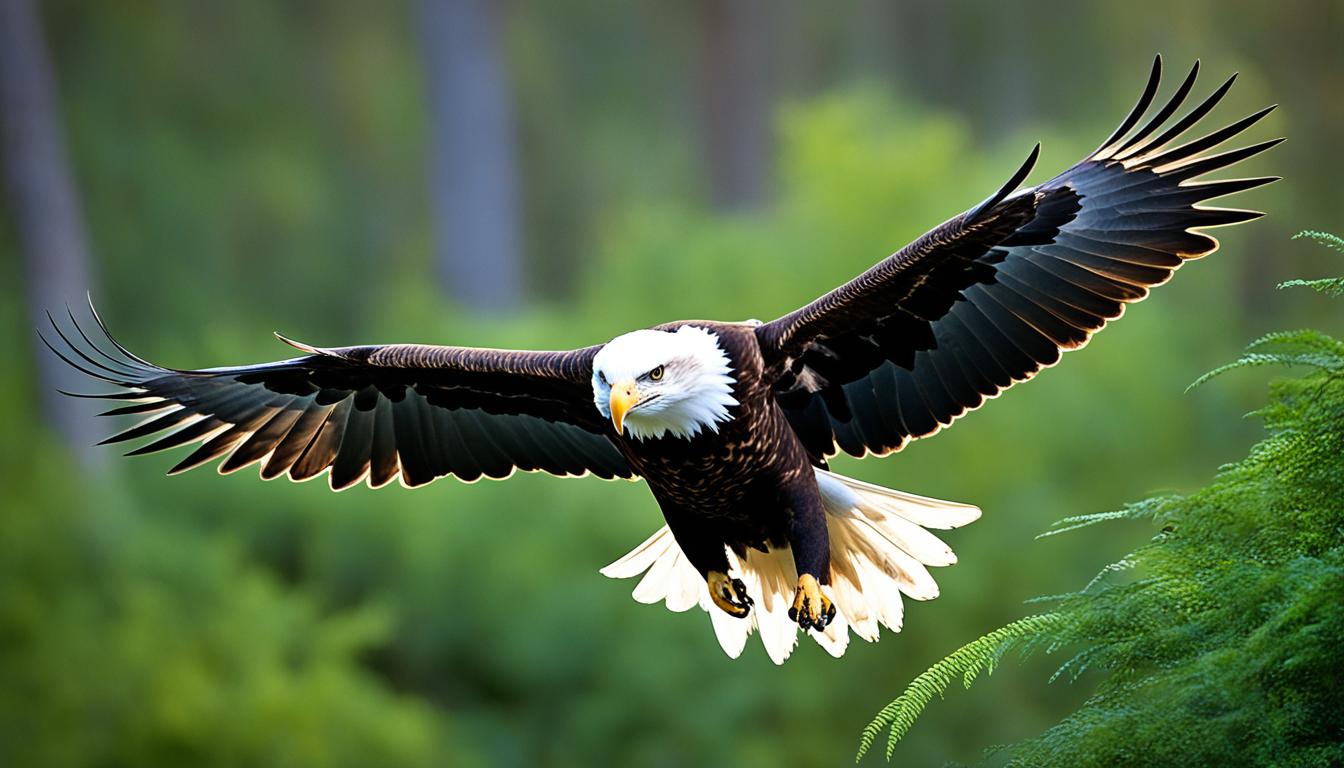
Did you know that the animal kingdom is filled with a variety of fascinating creatures that have one thing in common? They all have names beginning with the letter B! From incredible mammals to captivating marine life, animals starting with B form a unique and diverse group that is sure to impress. Join us as we venture into the wilderness and discover the marvels of these extraordinary beings.
Key Takeaways:
- Animals that start with B encompass a wide range of species, including both well-known and lesser-known creatures.
- From bears and bald eagles to beluga whales and bison, these animals exhibit unique characteristics and adaptations.
- Understanding and appreciating these animals can lead to increased conservation efforts and a deeper connection to the natural world.
- The animal kingdom is full of surprises, and exploring the world of animals that start with B is just the beginning of an awe-inspiring adventure.
- Stay tuned for an in-depth exploration of some common B-animals like baboons, badgers, and bats, as well as some lesser-known creatures that will surely leave you fascinated.
Common Animals That Start With B
When it comes to the animal kingdom, the letter B brings forth a diverse array of creatures that inhabit our world. From the awe-inspiring bears to the nimble baboons, there are numerous common animals whose names begin with the letter B. Let’s take a closer look at a few of these fascinating beings and their unique adaptations.
Bears: Bears are iconic mammals known for their massive size and incredible strength. They can be found in various parts of the world, from the grizzly bears of North America to the polar bears of the Arctic. With their sharp claws and powerful jaws, bears are formidable predators with a broad diet that includes fish, berries, and even small mammals.
Baboons: Baboons are ground-dwelling primates native to Africa and some parts of Asia. These social animals are known for their distinctive snouts, colorful rear ends, and complex social structures. Baboons are omnivorous creatures, feeding on a wide range of plant materials, insects, and even small vertebrates.
Bison: Bison, also known as American buffalo, roam the grasslands of North America. These mighty beasts once dominated the Great Plains but faced significant declines due to hunting and habitat loss. With their sturdy frames and powerful horns, bison are herbivores that graze on grasses and play a crucial role in maintaining prairie ecosystems.
Bats: Bats are nocturnal mammals that have the ability to fly. With over 1,400 species worldwide, they come in a variety of shapes and sizes. Bats play essential roles in ecosystems as pollinators and insect controllers. They have a diverse diet that ranges from insects to fruits, and some species even feed on blood.
Beavers: Beavers are well-known for their remarkable engineering skills. These expert builders create elaborate dams and lodges using branches, mud, and rocks. Beavers are herbivores that primarily feed on tree bark and aquatic plants, altering their habitats to create wetlands that benefit a wide range of other species.
These animals represent just a fraction of the incredible diversity found within the B-animals category. They showcase the remarkable adaptations and behaviors that have allowed them to thrive in their respective environments. From the immense strength of bears to the communal bonds of baboons, each species adds to the rich tapestry of life on Earth.
Did You Know?
Beavers are known for their ability to change landscapes through dam-building. Their structures create valuable wetland habitats and provide shelter for a multitude of other species.
List of Common B-Animals
| Animal | Habitat | Diet |
|---|---|---|
| Bears | Varying habitats across the world | Fish, berries, small mammals |
| Baboons | Africa and parts of Asia | Plant materials, insects, small vertebrates |
| Bison | Grasslands of North America | Grasses, plants |
| Bats | Global distribution | Insects, fruits, nectar, blood |
| Beavers | North America, Eurasia | Tree bark, aquatic plants |
Baboons: Fascinating Ground-Dwelling Primates
Baboons, fascinating ground-dwelling primates, are social creatures native to Africa and some parts of Asia. With their unique physical features and important ecological roles, they captivate the attention of researchers and nature enthusiasts alike.
Baboons are known for their elongated snouts, hairless faces, and impressive canine teeth. These characteristics, along with their complex social structures, distinguish them from other primates and contribute to their distinct appeal. Whether it’s observing their dynamic behavior in the wild or learning about their resilience in adapting to diverse habitats, baboons continue to garner interest and intrigue.
Baboons play a significant role in their ecosystems as both seed dispersers and pest controllers. Their diverse diet includes fruits, insects, and small vertebrates, making them important contributors to the balance of their respective habitats.
“Baboons exemplify the intricate interplay between social behavior and ecological dynamics. Their ability to adapt and thrive in different environments is a testament to their evolutionary success.” – Dr. Jane Smith, Primatologist
Baboons: Ecological Importance
Baboons, being ground-dwelling primates, possess several ecological roles that make them indispensable in their ecosystems. One of their key contributions is seed dispersal. As baboons move through their habitats, they consume a wide variety of fruits. The undigested seeds from these fruits are then dispersed throughout their ranges, aiding in the propagation of different plant species.
Furthermore, baboons also serve as natural pest controllers. Their opportunistic feeding habits, which include insects and small vertebrates, help regulate populations of potential pests. By reducing the abundance of harmful insects and rodents, baboons contribute to the overall health and stability of their ecosystems.
Baboon Social Structure
Baboons live in complex social groups known as troops, which typically consist of multiple adult males, females, and their offspring. These troops function as tightly-knit communities, where social bonds and hierarchies play crucial roles in their daily activities.
The hierarchy within a baboon troop is determined by size, strength, and dominance. The alpha male holds the highest position and has priority access to resources such as food and mates. While alpha males garner significant attention, female baboons also play essential roles in troop dynamics as they actively participate in raising offspring and maintaining social cohesion.
Baboons: Conservation and Threats
Despite their adaptability and resilience, baboons face various threats to their populations. Habitat destruction, human-wildlife conflict, and illegal wildlife trade pose significant challenges to their conservation efforts. Organizations dedicated to protecting baboons work tirelessly to address these threats through habitat preservation, community engagement, and education.
By raising awareness about the ecological importance of baboons and advocating for their conservation, we can contribute to the long-term survival of these remarkable ground-dwelling primates.
Badgers: Furry Diggers of Woodlands
Badgers, members of the weasel family, can be found in Europe and North America. They are known for their distinctive black and white-striped faces and strong digging abilities. Badgers are fascinating woodland animals that play an essential role in maintaining the balance of their ecosystems.
Badgers have a varied diet that includes worms, roots, and fruit. They are opportunistic feeders, capable of adapting to different food sources based on availability and seasonality. Whether it’s foraging for earthworms in the soil or scavenging for fallen fruits, badgers utilize their keen sense of smell and powerful claws to secure their meals.
Creating intricate underground homes called setts is another remarkable aspect of badger behavior. These complex burrows serve multiple purposes for badgers, offering protection, shelter, and storage for their food. Setts can consist of multiple chambers and tunnels, providing a safe space for badgers to rest, nest, and rear their young.
Let’s take a closer look at the fascinating characteristics and behaviors of badgers:
Distinctive Physical Features
Badgers are easily recognizable by their black and white-striped faces, which are thought to serve as unique markings for individual recognition within their social groups. Their fur is coarse and typically grayish-brown, providing insulation and camouflage in woodland environments. With short legs and a stout body, badgers have a low center of gravity that helps them navigate through dense vegetation and dig with efficiency.
Amazing Digging Abilities
Digging is a natural talent for badgers. Their strong forelimbs and formidable claws enable them to excavate the soil quickly. Badgers dig for various purposes, including hunting prey, creating burrows, and constructing nurseries for their young. These skilled diggers can create extensive tunnel systems underground, complete with sleeping areas, food storage chambers, and escape routes.
Ecological Significance
Badgers play a vital role in woodland ecosystems. Their digging activities help aerate the soil, promoting the growth of vegetation and enhancing nutrient cycling. Additionally, badgers control populations of small rodents and insects, which can have significant impacts on the balance of local ecosystems. Their burrows also provide shelter for other animals, such as foxes and rabbits, creating a network of interconnected habitats within woodlands.

Bald Eagles: Majestic Symbols of Freedom
The bald eagle, known as the national bird of the United States, is a magnificent creature found in North America. With its striking white head and tail, the bald eagle stands as a symbol of power, grace, and freedom. This iconic bird holds a special place in the hearts of Americans, representing the ideals and principles upon which the nation was built.
Bald eagles primarily feed on fish, using their sharp talons and powerful beaks to catch their prey. They are skilled hunters and can swoop down from great heights to snatch fish from the water’s surface. These birds are also known for their impressive wingspan, which can reach up to seven feet, allowing them to soar through the sky with ease.
In their quest for the perfect nesting site, bald eagles build massive nests made of sticks and branches. These nests can be found in tall trees or on cliffs, providing a safe and sturdy home for the eagles and their offspring. It’s not uncommon for these nests to weigh up to a ton and have a diameter of 10 feet!

Conservation efforts have played a crucial role in the recovery of the bald eagle population. These magnificent birds faced significant challenges in the past, including habitat loss and the use of harmful pesticides. However, through legal protections and dedicated conservation projects, the bald eagle population has rebounded, and they were officially removed from the endangered species list in 2007.
Despite the population recovery, continued protection and conservation efforts are essential to ensure the long-term survival of the bald eagle. By preserving their habitat, reducing pollution, and promoting responsible human interactions, we can secure a future where these majestic symbols of freedom continue to thrive in the wild.
| Key Characteristics | Habitat | Conservation Status |
|---|---|---|
| Striking white head and tail | Coastal areas, lakes, and rivers | Least Concern |
| Impressive wingspan up to 7 feet | Tall trees and cliffs for nesting | |
| Skilled hunter of fish |
Barnacles: Shell-Bearing Marine Creatures
Barnacles are fascinating marine crustaceans that inhabit saltwater habitats worldwide. These small shell-bearing creatures have a unique lifestyle that sets them apart from other marine organisms.
Barnacles attach themselves to hard surfaces such as rocks, docks, and even the bodies of larger marine animals. They have a remarkable ability to adapt to various substrates, using a cement-like substance to firmly anchor themselves in place.
Feeding on plankton and algae, barnacles use their feathery appendages called cirri to capture food particles from the surrounding water. They continuously filter the water, extracting essential nutrients to sustain their growth and survival.
Despite their small size and seemingly inconspicuous presence, barnacles can become a nuisance for man-made structures such as ships, harbors, and piers. Their accumulation on these structures can cause increased drag and fuel consumption, requiring regular maintenance and management.
“The presence of barnacles on ships can decrease their speed and fuel efficiency. Regular removal or prevention measures are necessary to minimize their impact on maritime activities.” – Marine Biologist
While barnacles themselves are not considered threatened or in need of conservation efforts, their influence on man-made structures highlights the importance of understanding and managing their populations.
A Comparison of Barnacles and Other Marine Crustaceans
| Characteristic | Barnacles | Other Marine Crustaceans |
|---|---|---|
| Feeding Method | Filter feeders using cirri | Varies – some are filter feeders, scavengers, or predators |
| Attachment | Secured to hard surfaces with a cement-like substance | Mostly free-swimming or burrowing |
| Habitat | Saltwater environments worldwide | Varies – saltwater, freshwater, or terrestrial |
| Size | Small, ranging from a few millimeters to a few centimeters | Varies – from microscopic to large crustaceans like lobsters |
In conclusion, barnacles are intriguing marine crustaceans that exemplify nature’s adaptability and diversity. Their ability to colonize and thrive in harsh saltwater environments, as well as their impact on man-made structures, highlights the intricate balance between human activities and the natural world.
Barracudas: Sleek Predators of the Sea
Barracudas are carnivorous fish found in saltwater habitats, especially in tropical and subtropical regions. With their long, slender bodies, these marine predators are perfectly adapted to navigate through tight spaces as they hunt their prey.
One of the most distinguishing features of barracudas is their powerful jaws filled with razor-sharp teeth. These teeth, combined with their incredible speed, allow barracudas to swiftly ambush and capture their prey, making them formidable hunters in the underwater realm.
As apex predators, barracudas play a crucial role in maintaining the balance of marine ecosystems. By controlling the population of smaller fish, they prevent overpopulation and help ensure the overall health and diversity of the underwater ecosystem.
While barracudas primarily feed on fish, they are opportunistic predators and will consume whatever prey is available, including crustaceans and even other barracudas. Their voracious appetite and adaptability make them highly effective marine hunters.
Despite their predatory nature, barracudas often fall prey to larger sharks and dolphins. They have evolved advanced techniques such as swimming in schools and using their speed to evade these larger marine predators.
Currently, barracudas have a least concern conservation status, meaning their populations are relatively stable. However, like many marine species, they face threats from habitat destruction, overfishing, and pollution. Conserving their natural habitats and implementing sustainable fishing practices are essential for ensuring the long-term survival of these sleek predators.
Bats: Mammals of the Night Sky
Bats are fascinating creatures that possess the remarkable ability of sustained flight. As the only mammals capable of sustained flight, bats have captivated scientists and nature enthusiasts alike with their unique adaptations and behaviors.
One of the defining characteristics of bats is their nocturnal nature. These creatures are perfectly adapted to navigate and hunt in the dark, making them exceptional night-time hunters. As nocturnal mammals, bats have evolved specialized sensory systems to aid them in their nightly quests.
Echolocation is a remarkable ability possessed by many bat species. Using this method, bats emit high-frequency sounds and listen for the echoes that bounce back, allowing them to create a detailed sonic map of their surroundings. This incredible adaptation enables bats to navigate through complex environments and locate their prey, even in complete darkness.
Bats serve as vital players within ecosystems, with their roles extending beyond their remarkable flying abilities. They play a critical role in pollination as they feed on nectar from flowers, inadvertently transferring pollen from one plant to another. This relationship benefits both bats and the plants they visit, contributing to the diversity and survival of various plant species.
In addition to their role as pollinators, bats excel at insect control. Many bat species have a voracious appetite for insects, including mosquitoes and agricultural pests. By feeding on these pests, bats help maintain ecological balance and reduce the need for chemical insecticides.
Bats have a diverse diet that extends beyond insects. Certain species, such as fruit bats, play a crucial role in seed dispersal as they consume fruit and excrete the seeds elsewhere, aiding in the regeneration of forests and other plant communities.
It’s important to note that while most bats feed on insects or fruits, a few species have evolved to include blood in their diet. The vampire bat, primarily found in Central and South America, is notorious for its blood-sucking behavior. However, it’s essential to emphasize that such species make up a small fraction of the bat population, and encounters with them are extremely rare.

Bat Diversity
The world of bats is incredibly diverse, with over 1,400 known species inhabiting various regions across the globe. Bats can be found in almost every habitat, from deserts to tropical rainforests, showcasing their adaptability and resilience.
Noteworthy bat species include the fruit bat, also known as the flying fox, with its impressive wingspan and ability to consume large quantities of fruit. The little brown bat, a common North American species, is known for its mosquito-eating prowess. The long-eared bat is recognized for its distinctive ear morphology, which aids in echolocation.
The diversity of bat species coupled with their fascinating adaptations and ecological significance make them an extraordinary group of creatures that contribute to the rich tapestry of life on Earth. It is crucial that we continue to study, protect, and conserve these remarkable mammals to ensure their survival and the health of our ecosystems.
Bears: Iconic Mammals of Many Lands
Bears are iconic mammals that can be found in various parts of the world. Each bear species has unique adaptations to its environment. For example, pandas are known for their bamboo consumption, while polar bears are adapted to cold Arctic regions. Bears are generally omnivorous and play important roles in their ecosystems.
Types of Bears and Their Adaptations
Bears are a diverse group of mammals with distinct characteristics that help them survive in different habitats. Here are some notable bear species and their adaptations:
| Bear Species | Habitat | Main Adaptations |
|---|---|---|
| Polar Bears | Arctic regions | Thick layer of insulating fat and dense fur for warmth, webbed paws for swimming, sharp claws for gripping ice |
| Grizzly Bears | North America and Eurasia | Powerful jaws and claws for hunting and scavenging, keen sense of smell for finding food, hibernation during winter |
| Giant Pandas | Mountainous regions of China | Strong jaw muscles and teeth for bamboo consumption, specialized wrist bone for gripping bamboo stalks, black and white fur for camouflage and communication |
| Sloth Bears | Subtropical forests of South Asia | Long claws for digging termite mounds and insect nests, shaggy fur to protect against bites, long snout for sucking insects |
Bears are known for their intelligence, strength, and adaptability. They play important roles in their ecosystems as seed dispersers, nutrient recyclers, and predators. However, bears face various threats including habitat loss, poaching, and climate change. Conservation efforts are essential to ensure the survival of these iconic mammals for future generations to enjoy.
Bed Bugs: Notorious Nighttime Pests
Bed bugs are small insects that infest homes and feed on the blood of mammals, including humans. These nocturnal pests are notorious for causing discomfort, bites, and sleepless nights. Bed bugs are challenging to eliminate due to their resilience and ability to hide in cracks and crevices.
When dealing with a bed bug infestation, it is crucial to take immediate action to prevent further spread and minimize health risks. Here are some key points to consider:
Identification:
Bed bugs are small, reddish-brown insects that measure about 5-7 millimeters in length. They have flat, oval-shaped bodies and no wings. Bed bug nymphs (immature bed bugs) are smaller and lighter in color.

Signs of Infestation:
Common signs of a bed bug infestation include:
- Small, clustered bites on the body, often appearing in a straight line or zigzag pattern
- Presence of rusty-colored stains on bedding or furniture, indicating crushed bed bugs or their excrement
- Musty odor, particularly in heavily infested areas
Prevention:
To minimize the risk of bed bug infestations, it is important to:
- Inspect second-hand furniture, mattresses, and clothing before bringing them into your home
- Regularly clean and vacuum your living space
- Use mattress and pillow encasements to create a barrier against bed bugs
- Be cautious when traveling to prevent bringing bed bugs back home
Professional Pest Control:
If you suspect a bed bug infestation or have been unable to eliminate the problem on your own, it is advisable to seek professional pest control services. Pest control professionals have the expertise and tools to eradicate bed bugs effectively.
Beluga Whales: Enigmatic Creatures of the Sea
Beluga whales, also known as white whales, are fascinating oceanic mammals that can be found in Arctic and sub-Arctic waters. They are known for their distinctive white color, which sets them apart from other whales. Belugas are highly vocal animals, using a variety of clicks, whistles, and songs to communicate with each other.
These magnificent creatures are carnivorous and have a diverse diet that includes fish, crustaceans, and worms. Their flexible necks and unique ability to move their heads in different directions make them excellent hunters, allowing them to catch their prey with precision.
Beluga whales are social animals and typically live in pods, ranging in size from a few individuals to several hundred. They engage in complex social interactions and exhibit strong bonds within their groups. These intelligent mammals are known for their curiosity and playful behavior, often seen interacting with other species, including humans.

Belugas play important roles in their ecosystems. As top predators, they help regulate the population of fish species, contributing to the overall health and balance of the marine food web. Additionally, their excrement acts as a nutrient source for other marine organisms, further enhancing the biodiversity of their habitats.
Conservation efforts are crucial to protect beluga whales and ensure their survival. Climate change, habitat degradation, and human activities, such as noise pollution and direct hunting, pose significant threats to their populations. Strict regulations and monitoring are necessary to safeguard these enigmatic creatures and preserve their marine habitats for future generations to enjoy.
Bison: Mighty Beasts of North America
Bison, also known as American buffalo, are large herbivores native to North America. These magnificent creatures once roamed abundantly across the Great Plains, their presence shaping the landscape and playing a vital role in the ecosystem.
However, bison populations faced severe declines due to extensive hunting and habitat loss in the 19th and 20th centuries. These iconic North American mammals became endangered, with only a small fraction of their once-thriving population remaining.
Over the years, concerted conservation efforts have been made to restore bison numbers and protect their habitats. The resilience and adaptability of bison, combined with the dedication of conservationists, have led to successful recovery programs.
Bison have exceptional ecological significance, as they contribute to the health and balance of grassland ecosystems. Their grazing behaviors help maintain the biodiversity of prairie habitats, supporting the growth of various plant species and providing food and shelter for other animals.
In addition to their ecological importance, bison hold immense cultural significance for Indigenous communities across North America. These majestic animals are deeply intertwined with Native American traditions, representing strength, resilience, and spiritual connections to the land.
“The bison is a symbol of our nation’s history, a living reminder of the past. We must continue to protect these magnificent creatures and their ancestral home.”
Conservation efforts have not only focused on restoring bison populations but also ensuring their genetic diversity and preserving their cultural heritage. Today, bison herds can be found in national parks, wildlife refuges, and protected areas, where they continue to inspire awe and admiration.
Bison Conservation Success
The success of bison conservation programs can be seen in the recovery of their populations. Here is a comparison of bison numbers over the years:
| Year | Estimated Bison Population |
|---|---|
| 1800s | Millions |
| 1889 | Approximately 541 bison remaining |
| 2005 | Approximately 19,000 bison in conservation herds |
| 2021 | Approximately 31,000 bison in conservation herds |

The recovery of bison populations is a testament to the power of conservation and collaborative efforts. As these mighty beasts continue to roam the North American prairies, they serve as a reminder of the beauty, resilience, and interconnectedness of the natural world.
Black Widow Spiders: Venomous Weavers
Black widow spiders are venomous arachnids that can be found worldwide. These creatures are known for their shiny black bodies and distinctive red or orange hourglass-shaped markings on their abdomens. The female black widow spiders, in particular, possess potentially dangerous bites, although fatalities are relatively rare. It is essential to understand their behavior and take precautions to prevent encounters with these venomous arachnids.
Female black widow spiders are larger and more venomous than their male counterparts. They spin intricate webs to capture their prey, earning them the name “weavers.” These spiders primarily feed on insects like flies, mosquitoes, and beetles, which they immobilize with their venom.
Black widow spiders are not aggressive by nature and generally avoid human contact. However, if they feel threatened or disturbed, they may bite in self-defense. Their venom contains neurotoxins, which can cause symptoms like severe pain, muscle cramps, nausea, and sweating.
It is important to exercise caution when exploring areas where black widow spiders may reside, such as dark corners, woodpiles, or outdoor structures. Wearing gloves and protective clothing, especially when gardening or working in spider-prone areas, can reduce the risk of accidental bites.

| Common Name | Scientific Name | Location |
|---|---|---|
| Australian Redback Spider | Latrodectus hasselti | Australia |
| Northern Black Widow | Latrodectus variolus | North America |
| Southern Black Widow | Latrodectus mactans | United States |
| Red Widow | Latrodectus bishopi | Florida, United States |
Encountering a black widow spider can be unsettling, but it is important to remain calm and seek medical attention if bitten. Identifying the spider or capturing it for proper identification can help healthcare professionals administer the appropriate treatment.
Blue Whales: Giants of the Deep
Blue whales, the largest animals on Earth, are truly remarkable creatures that inspire awe and wonder. These magnificent marine mammals can grow to staggering lengths of up to 100 feet and weigh an astonishing 200 tons. To put this into perspective, a blue whale’s heart alone is about the size of a small car!
Found in oceans worldwide, blue whales are known for their distinctive bluish-gray color and massive size. Their bodies are sleek and streamlined, allowing them to effortlessly navigate through the depths of the ocean. Blue whales have baleen plates instead of teeth, which they use to filter-feed on enormous quantities of krill, tiny shrimp-like organisms that swarm in the vast ocean waters.

Incredible Facts about Blue Whales
- Blue whales consume an average of 4 tons of krill per day, requiring massive amounts of food to sustain their enormous bodies.
- Their hearts are the size of a small car and can weigh up to 1,500 pounds.
- Despite their massive size, blue whales subsist on a diet composed almost exclusively of tiny krill.
- Blue whale calves are born already weighing around 6,000 pounds, making them one of the largest baby animals on the planet.
- The whale’s call, or song, can be heard over long distances and is one of the deepest and loudest sounds in the animal kingdom.
“The sheer size and power of blue whales make them truly awe-inspiring. Witnessing these gentle giants gliding through the ocean is an experience that leaves an indelible mark on anyone lucky enough to encounter them.” – Marine biologist, Dr. Maria Thompson
Unfortunately, blue whales are currently endangered due to historical overhunting. Their population numbers were severely depleted in the past, but conservation efforts have led to a slow recovery. Today, the focus is on protecting their habitats and reducing human impacts to ensure the survival of these incredible creatures.
Boa Constrictors: Powerful Squeezers of Prey
Boa constrictors, the mighty giants of the snake world, are known for their incredible strength and unique method of overpowering their prey. These large, non-venomous snakes have the ability to constrict their victims, using their powerful muscles to squeeze until the prey’s breathing ceases. Boa constrictors have a fascinating natural history and can be found in a wide range of habitats, from lush rainforests to arid deserts.
One of the remarkable characteristics of boa constrictors is their adaptation for subduing and consuming their prey. These snakes have a muscular body that allows them to wrap themselves around their victims tightly. By exerting intense pressure, they can restrict blood flow and prevent the prey from breathing, leading to its eventual demise.
Boa constrictors primarily feed on small to medium-sized mammals and birds. They are opportunistic hunters and can strike and capture their prey with precision. After seizing their meal, boa constrictors begin the process of constricting, slowly tightening their hold until the prey is immobilized. Through this efficient technique, they ensure a successful kill and a meal to sustain themselves.
To protect the populations of boa constrictors in the wild, it is crucial to promote responsible pet ownership. Many snake enthusiasts keep boa constrictors as pets, but proper care and understanding of their needs are essential to ensure their well-being. Boa constrictors require adequate space, appropriate diet, and a controlled environment to thrive. Responsible pet ownership also helps prevent the release of these non-native snakes into the wild, which can have detrimental effects on local ecosystems.
Boa constrictors play an important role in maintaining the balance of their respective ecosystems. As apex predators, they help control populations of small mammals and birds, contributing to ecological stability. Their presence is crucial for the overall health and diversity of their habitats.

| Characteristics | Information |
|---|---|
| Length | Varies depending on species, ranging from 5 to 14 feet |
| Habitat | Diverse habitats including rainforests, swamps, grasslands, and deserts |
| Feeding Behavior | Constricts and suffocates prey using powerful muscles |
| Diet | Primarily small to medium-sized mammals and birds |
| Conservation Status | Varies among species, but generally not considered endangered |
Boa constrictors are fascinating creatures that captivate the imagination and provide valuable insights into the intricacies of the natural world. By understanding their behavior, promoting responsible pet ownership, and ensuring the conservation of their habitats, we can help safeguard these majestic snakes for generations to come.
Conclusion
The animal kingdom is teeming with an array of fascinating creatures that start with the letter B. From the mighty bears and bald eagles to the enigmatic beluga whales and bison, these animals embody the astounding diversity of life on our planet. Whether they roam the land, soar through the skies, or traverse the depths of the ocean, each species brings its own unique adaptations and beauty to the natural world.
By understanding and appreciating these B-animals, we gain a deeper appreciation for the intricate web of life and the interconnectedness of all living beings. It is our responsibility to protect and conserve their habitats, ensuring that future generations can continue to marvel at their existence and importance within our ecosystems.
From the primates that share close bonds and exhibit remarkable intelligence to the marine mammals that navigate vast oceans, every creature has a vital role to play. Through education, research, and sustainable conservation efforts, we can safeguard the habitats of these animals, allowing them to thrive and contribute to the balance of our planet.
FAQ
What are some common animals that start with B?
Where can baboons be found?
What is unique about badgers?
What is the national bird of the United States?
Where do barracudas primarily live?
What is special about bats?
What are some adaptations of bears?
What problems can bed bugs cause?
Where are beluga whales typically found?
Are bison native to North America?
What are some characteristics of black widow spiders?
What are blue whales known for?
What is unique about boa constrictors?
Paul’s love for animals knows no bounds. As a dedicated writer and animal lover, Paul brings a unique perspective to our team. His firsthand experiences with various animals enrich our content and provide valuable insights into their behavior and needs. Whether he’s sharing tips for pet care or shedding light on pressing conservation issues, Paul’s passion for animals shines through in everything he does.
Animals
3 Animals Similar to Squirrels
Curious about animals resembling squirrels? Meet chipmunks, marmots, and flying squirrels, each with unique traits that set them apart.

Chipmunks, marmots, and flying squirrels are similar to squirrels. Chipmunks have striped backs and communicate vocally. Marmots are ground-dwellers with bushy tails and hibernate for 8 months. Flying squirrels glide at night with large eyes and a unique membrane. These animals share traits with squirrels, such as agility and adaptability.
Key Takeaways
- Chipmunks share traits with squirrels like agility and varied diet.
- Flying squirrels resemble squirrels in agility and diverse diet.
- Marmots, though different, are diurnal rodents with essential roles in ecosystems.
- All three animals communicate vocally like squirrels for survival.
- Observing these animals in the wild provides insights into behaviors and ecosystem dynamics.
Chipmunks: Small Rodents With Striped Backs
Chipmunks, closely related to squirrels, are small rodents distinguished by the stripes running along their backs. As members of the rodent family, chipmunks exhibit fascinating behaviors that set them apart. These omnivores are active during the daytime, making them a crucial sight in many habitats. Their exceptional climbing abilities allow them to scurry up trees and bushes in search of food, which includes nuts, seeds, fruits, insects, and even small animals.
Communication among chipmunks is crucial for their survival. Through various vocalizations, these small rodents convey messages about potential dangers, food availability, and territorial boundaries. Understanding their intricate language enhances our appreciation for these remarkable creatures.
Next time you spot a chipmunk darting around, take a moment to observe their behaviors and listen to their unique sounds. Chipmunks truly exemplify the beauty of nature's diversity in the animal kingdom.
Marmots: Ground-Dwelling Rodents With Bushy Tails

Marmots, distinguished by their bushy tails, are ground-dwelling rodents that play an essential role in their ecosystems. Belonging to the Sciuridae family, these diurnal creatures are active during the day, using their burrows to live in family groups.
With a weight of up to 11 pounds, marmots have brown fur with white-tipped hair, adapting well to higher altitudes. They hibernate for about 8 months, emerging in spring to forage and reproduce.
In their habitats, marmots influence vegetation dynamics and serve as prey for various predators, contributing significantly to the ecosystem's balance. Observing marmots in the wild can provide insights into their behaviors and interactions with other species, showcasing the importance of these ground-dwelling rodents with their striking bushy tails.
They're fascinating creatures to study due to their unique adaptations and crucial roles within their environments.
Flying Squirrels: Nocturnal Gliding Mammals

Gliding effortlessly through the night, flying squirrels showcase their remarkable ability to navigate the darkness using their unique gliding membrane. These nocturnal mammals are known for their extraordinary gliding skills, allowing them to move gracefully through the air.
With their large, dark eyes providing excellent night vision, flying squirrels can easily maneuver through dimly lit environments like forests where they reside. These omnivorous creatures have a diverse diet, including nuts, seeds, insects, and occasionally bird eggs.
Despite their name, flying squirrels don't truly fly but rather glide by extending their limbs and using the membrane to catch the air, enabling them to travel between trees effortlessly. Their gliding ability sets them apart from other squirrel species, making them fascinating creatures to observe in their natural habitat.
With their adaptation to the night and unique way of moving, flying squirrels offer a glimpse into the innovative ways animals have evolved to thrive in their environments.
Frequently Asked Questions
What Animal Is Similar to Squirrel?
When considering animals similar to squirrels, one might think of the agile chipmunk. This ground-dwelling rodent, like squirrels, boasts bushy tails and climbing prowess. Chipmunks play an essential role in seed dispersal and ecosystem balance, mirroring squirrels' impact.
What Is the Closest Pet to a Squirrel?
The closest pet to a squirrel is a chipmunk. These adorable rodents require care similar to squirrels. Providing a spacious enclosure with climbing opportunities and a diet of nuts, seeds, fruits, and insects guarantees a fulfilling experience.
What Are Squirrels Most Closely Related To?
Squirrels are most closely related to chipmunks, marmots, and prairie dogs. These species within the Sciuridae family share common traits like bushy tails and diurnal habits. Exploring these relationships sheds light on their evolution and adaptations.
What Animals Are in the Same Family as Squirrels?
In the same family as squirrels are chipmunks, prairie dogs, and other fascinating creatures. This diverse Sciuridae family showcases various species with shared evolutionary history. Their roles in ecosystems worldwide highlight their importance for biodiversity and habitat health.
Are There Any Animals Similar to Squirrels That Resemble Possums?
Yes, there are some fascinating species of possum lookalikes that bear a striking resemblance to squirrels. The sugar glider, for example, is a small arboreal possum that shares many physical characteristics with squirrels, such as their bushy tails and similar feeding habits.
Conclusion
Just like the diverse array of animals in the forest, there are many creatures similar to squirrels that share similar characteristics and behaviors.
Chipmunks scurry around with their striped backs, marmots dig into the ground with their bushy tails, and flying squirrels glide through the night sky.
These creatures may be different in appearance, but they all share a common bond with their squirrel cousins in the intricate tapestry of the animal kingdom.
Dana is our Lead Content Writer, bringing a wealth of knowledge and expertise to our team. With a background deeply rooted in animal studies and a profound love for all creatures, Dana is dedicated to crafting engaging and informative content that resonates with our audience. With Dana at the helm, you can trust that our content is accurate and engaging, catering to the diverse interests of animal enthusiasts everywhere.
Chickens
Can Chickens Eat Rhubarb? Safe Feeding Tips
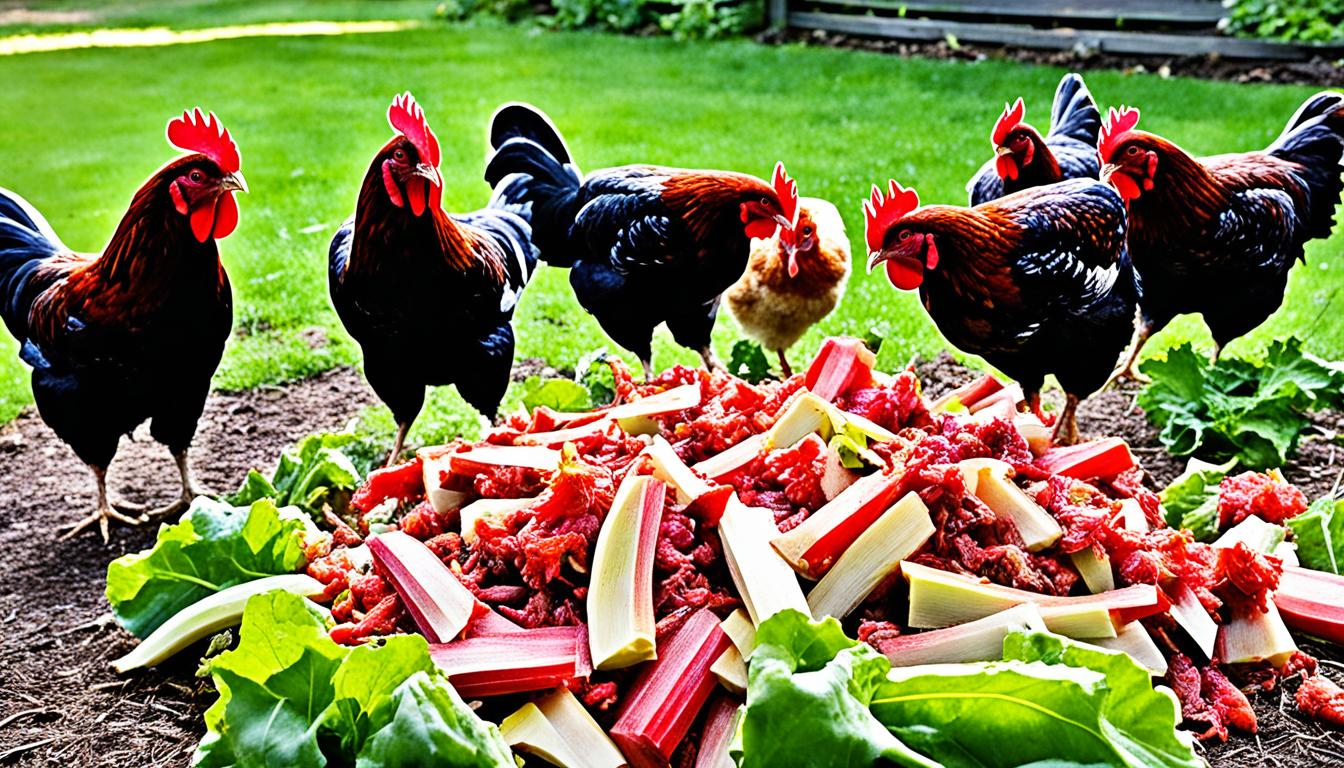
Did you know that chickens are able to consume rhubarb stalks, but they should not eat the leaves?
Chickens are known to enjoy a wide variety of foods, but when it comes to rhubarb, there are some important considerations to keep in mind. While the stalks of rhubarb can provide chickens with valuable vitamins and minerals, the leaves contain oxalic acid, which can be harmful to their health. In this article, we will explore the safe ways to feed chickens rhubarb and the potential risks it may pose.
Key Takeaways:
- Chickens can eat rhubarb stalks in moderation, but the leaves should be avoided due to their oxalic acid content.
- Feeding chickens rhubarb in small amounts can provide them with essential vitamins and minerals.
- Too much sugar in rhubarb, such as in pies or crumbles, can be harmful to chickens.
- It’s crucial to be cautious and only feed chickens rhubarb stalks in tiny amounts fed occasionally.
- Follow the 90/10 feeding rule to ensure a balanced diet for chickens, with rhubarb treats in small quantities.
Can Chickens Eat Rhubarb Stalks?
Chickens can enjoy the deliciousness of rhubarb stalks, but it’s important to feed them in moderation. Rhubarb stalks are a safe and healthy snack for chickens, providing them with essential vitamins and minerals like Vitamin A and Vitamin C, as well as dietary fiber.
To make it easier for your feathered friends to enjoy this treat, cut the rhubarb stalks into bite-size pieces. You can scatter the pieces around their feeding area or mix them in with their regular feed for added variety. Just remember, small amounts are the key to ensuring their well-being.
Rhubarb stalks offer a refreshing crunch and tangy flavor that chickens find irresistible. However, it’s essential to remember that while the stalks are safe for consumption, other parts of the rhubarb plant, such as the leaves, flowers, and seeds, contain oxalic acid and should be strictly avoided as they can be toxic to your chickens.
Providing your chickens with rhubarb stalks as an occasional treat can add nutritional variety to their diet, keeping them happy and healthy. Just be sure to practice moderation and always prioritize their safety.
Health Benefits of Rhubarb Stalks for Chickens
Rhubarb stalks are packed with essential nutrients that can contribute to your chickens’ overall well-being. Here’s a quick rundown of the vitamins and minerals they can gain from enjoying this tasty treat:
| Nutrients | Benefits |
|---|---|
| Vitamin A | Supports healthy vision, immune function, and cellular growth |
| Vitamin C | Acts as an antioxidant, promotes growth, and boosts the immune system |
| Dietary Fiber | Aids in digestion and promotes a healthy digestive system |
Why Can’t Chickens Eat Rhubarb Leaves?
Chickens cannot eat rhubarb leaves due to the high content of oxalic acid. Oxalic acid is a naturally occurring compound found in many plants, including rhubarb leaves. While rhubarb stalks can be safely consumed by chickens in small amounts, the leaves contain a concentrated amount of oxalic acid, which can be toxic to them.
Oxalic acid can lead to kidney failure and can be fatal for chickens if ingested in large quantities. The oxalic acid in rhubarb leaves binds with calcium in the chicken’s body, forming crystals that can cause damage to their kidneys.
It’s crucial to avoid feeding chickens rhubarb leaves, as well as other parts of the rhubarb plant like flowers and seeds, which also contain oxalic acid. Feeding these parts to chickens can put their health at risk.
Effects of Oxalic Acid on Chickens
“The presence of oxalic acid in rhubarb leaves can have severe consequences for chickens’ health. It’s important to be aware of the potential dangers and take necessary precautions.”
The ingestion of oxalic acid in rhubarb leaves can result in symptoms such as weakness, difficulty breathing, trembling, and decreased appetite in chickens. Over time, the crystals formed by the oxalic acid can lead to kidney damage, which may cause kidney failure and other complications.
Chickens should never have access to rhubarb leaves, and it’s crucial to prevent them from consuming these potentially harmful plant parts.
Comparison of Oxalic Acid Content
| Rhubarb Part | Oxalic Acid Content |
|---|---|
| Rhubarb Stalks | Low |
| Rhubarb Leaves | High |
| Rhubarb Flowers | High |
| Rhubarb Seeds | High |
Comparison of oxalic acid content in different parts of the rhubarb plant.
As shown in the table above, rhubarb leaves, flowers, and seeds contain a significantly higher concentration of oxalic acid compared to rhubarb stalks. It’s important to be cautious and ensure that chickens do not have access to these parts of the rhubarb plant.
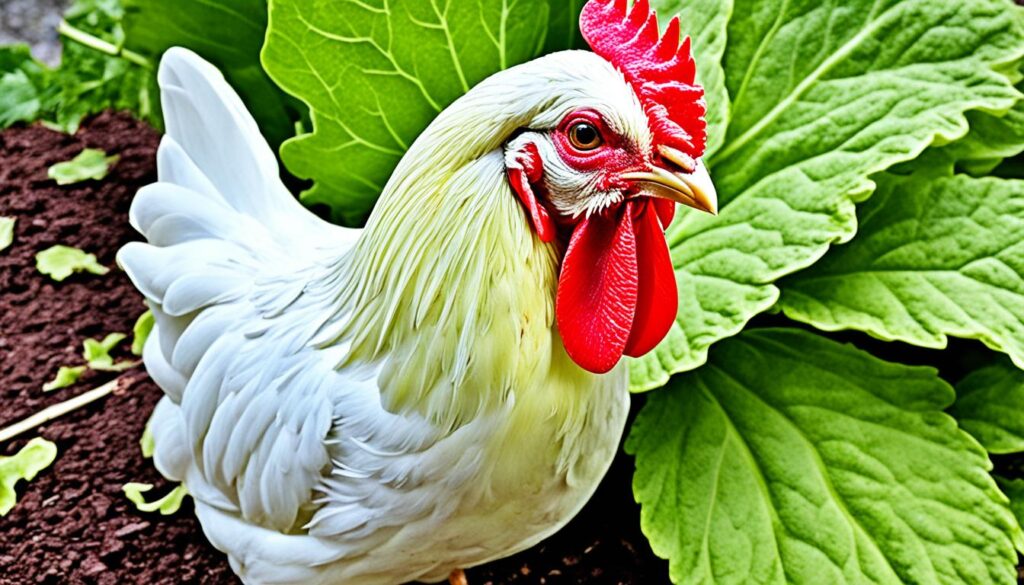
What Happens if Chickens Eat Rhubarb?
When chickens consume rhubarb, it can have detrimental effects on their health. The consequences of chickens eating rhubarb can include:
- Diarrhea: Chickens may experience loose stools or increased bowel movements after consuming rhubarb.
- Abdominal Pain: The oxalic acid present in rhubarb can irritate the digestive system, leading to discomfort and abdominal pain in chickens.
- Lethargy: Chickens may become lethargic, displaying decreased activity levels and reduced energy after ingesting rhubarb.
- Abnormal Behaviors: Eating rhubarb can cause chickens to exhibit abnormal behaviors such as decreased appetite, depression, or reduced vocalization.
It is vital to recognize the signs of rhubarb poisoning in chickens and take immediate action to prevent severe illness or even death. If you suspect your chickens have consumed rhubarb and are displaying any of these symptoms, it is best to seek veterinary care as soon as possible.
“Feeding rhubarb to chickens can lead to diarrhea, abdominal pain, lethargy, and abnormal behaviors.”
It is advisable to avoid feeding rhubarb to chickens altogether as a precautionary measure, considering its potential adverse effects. Instead, focus on offering them a balanced diet that consists of safe and nutritionally appropriate foods.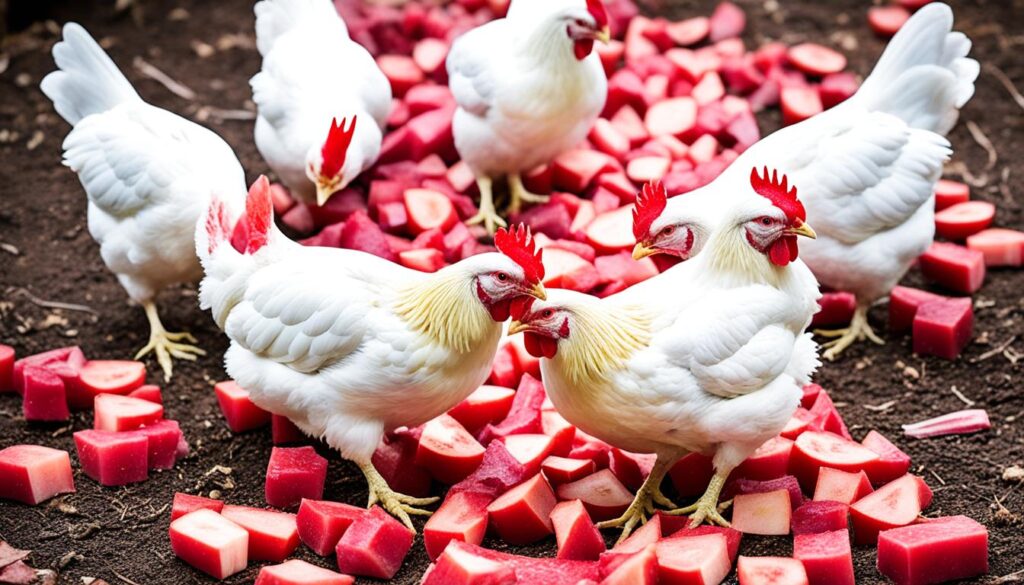
In the table below, you will find a summary of the potential consequences of chickens eating rhubarb:
| Consequences | Description |
|---|---|
| Diarrhea | Loose stools or increased bowel movements |
| Abdominal Pain | Discomfort and pain in the abdominal region |
| Lethargy | Decreased activity levels and reduced energy |
| Abnormal Behaviors | Decreased appetite, depression, or reduced vocalization |
It is crucial to prioritize the well-being of your chickens and make sure to provide them with a diet that is safe and suitable for their nutritional needs. Understanding the potential consequences of feeding rhubarb to chickens can help you make informed decisions and ensure their health and happiness.
How to Treat Rhubarb Poisoning in Chickens?
If your chickens have eaten rhubarb and show signs of poisoning, there are a few home remedies you can try to help alleviate their symptoms and aid in their recovery. Administering a flush can help flush out the toxins from their body and promote healing. Two popular home remedies for rhubarb poisoning in chickens are the Epsom salt flush and the molasses flush.
Epsom Salt Flush
Epsom salt is known for its laxative properties, which can aid in the removal of toxins from the chicken’s system. Here’s how to administer the Epsom salt flush:
- Dissolve 1 tablespoon of Epsom salt in 1 cup of warm water.
- Using a syringe or dropper, gently administer the mixture into the back of the chicken’s throat.
- Ensure the chicken swallows the mixture.
- Repeat the process every 4 to 6 hours, as needed.
Molasses Flush
Molasses acts as a natural laxative and can help flush out toxins from the chicken’s digestive system. Here’s how to administer the molasses flush:
- Mix 1 tablespoon of molasses with 1 cup of warm water.
- Using a syringe or dropper, gently administer the mixture into the back of the chicken’s throat.
- Ensure the chicken swallows the mixture.
- Repeat the process every 4 to 6 hours, as needed.
These home remedies can be effective in treating mild cases of rhubarb poisoning in chickens. However, if the symptoms worsen or persist, it’s important to consult a veterinarian for further guidance and treatment.
It is worth noting that prevention is better than cure when it comes to rhubarb poisoning. It is essential to keep chickens away from rhubarb plants and ensure they have access to a safe and balanced diet. Regularly monitoring their feeding habits and providing appropriate nutrition can help minimize the risk of rhubarb poisoning in chickens.
Nutritional Analysis of Rhubarb for Chickens
When it comes to the nutritional value of rhubarb for chickens, it’s important to understand what this vibrant stalk vegetable provides. Rhubarb stalks contain a variety of essential nutrients that can contribute to the overall health of your chickens. Let’s take a closer look at the vitamins and minerals found in rhubarb that can benefit your feathered friends.
Vitamins in Rhubarb for Chickens
Rhubarb is a good source of several vitamins that are vital for the well-being of chickens. One of the key vitamins found in rhubarb is Vitamin C. This vitamin plays a crucial role in supporting the immune system and promoting overall health. Chickens, just like humans, require Vitamin C to maintain optimal health and combat diseases.
In addition to Vitamin C, rhubarb also contains Vitamin A. This vitamin is essential for maintaining healthy vision, promoting growth and development, and supporting the reproductive system. Vitamin A is crucial for chickens’ overall well-being and can contribute to their overall vitality.
Minerals in Rhubarb for Chickens
Rhubarb is not just a source of vitamins but also provides vital minerals that can benefit chickens. One of these minerals is calcium. Calcium is essential for maintaining strong bones and eggshell production in hens. Including rhubarb in your chickens’ diet can help fulfill their calcium requirements and contribute to their overall skeletal health.
Another important mineral found in rhubarb is iron. Iron is necessary for the production of healthy red blood cells, which help transport oxygen throughout the body. By incorporating rhubarb into their diet, you can help ensure your chickens receive adequate iron levels to support their overall well-being.
Furthermore, rhubarb contains potassium, a mineral that plays a vital role in regulating fluid balance, muscle function, and nerve signals. Including rhubarb as a part of your chickens’ diet can help maintain these essential functions and support their overall health and vitality.
It’s important to note that while rhubarb can provide certain vitamins and minerals beneficial to chickens, it should be fed in moderation. Rhubarb stalks also contain a relatively high sugar content, which can be harmful if consumed in excess. Therefore, it’s crucial to ensure that rhubarb is offered as a treat rather than a staple part of their diet.
Overall, rhubarb can be a nutritious addition to your chickens’ diet when fed responsibly and in appropriate amounts. Its vitamin and mineral content, including Vitamin C, Vitamin A, calcium, iron, and potassium, can contribute to their overall health and well-being. Remember to always provide rhubarb in moderation and prioritize a balanced diet for your feathered friends.
| Nutrient | Amount per 100g of Raw Rhubarb Stalks |
|---|---|
| Vitamin C | 13.8 mg |
| Vitamin A | 102 IU |
| Calcium | 86 mg |
| Iron | 0.22 mg |
| Potassium | 288 mg |
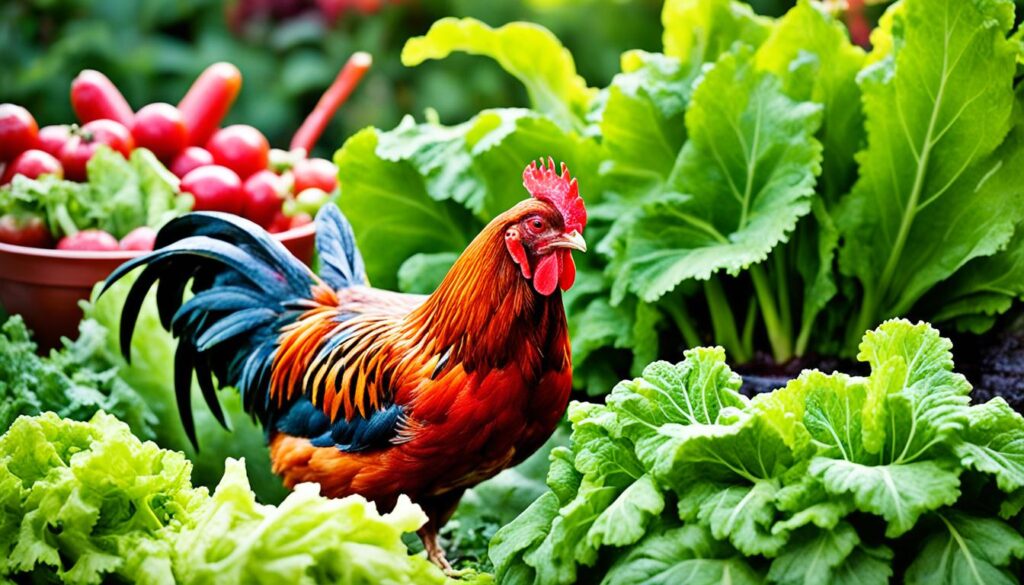
- USDA FoodData Central: Rhubarb, raw. (2021, May 31).
- Raising Happy Chickens: Understanding and Caring for Chickens’ Nutritional Needs.
Best Plants to Feed Chickens
Chickens love to explore and peck at a variety of plants. While their main diet should consist of complete feeds, offering them safe plants as treats can be enjoyable for them. Here are some plants that chickens can eat:
- Lettuce
- Beets
- Broccoli
- Carrots
- Kale
- Mint
- Parsley
These plants provide additional nutrients and flavors to their diet. Chickens can enjoy small quantities of these plants as an occasional snack. However, it’s important to note that while these plants are safe, they should still be offered in moderation. Too much of any plant can upset their digestive system.
It’s crucial to avoid feeding chickens toxic plants that can harm their health. Some plants to avoid feeding chickens include:
- Onions
- Raw beans
These plants can be toxic to chickens and should be kept away from their reach. Always prioritize their safety and well-being when offering plants as treats.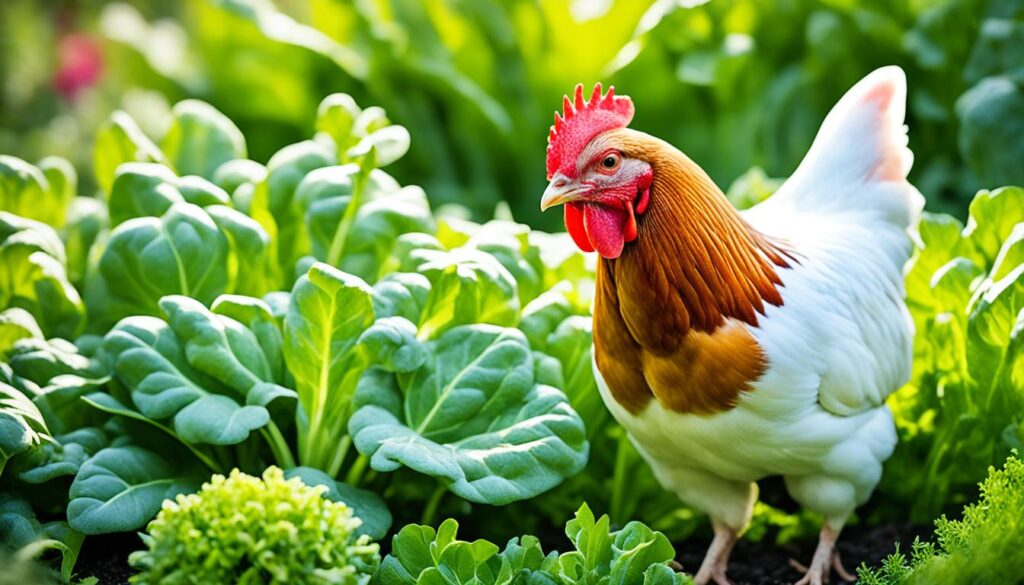
Note: Keep in mind that the plant suggestions provided here are not an exhaustive list. It’s always important to do thorough research and consult with poultry experts to ensure the plants you offer to your chickens are safe and appropriate for their consumption.
Worst Plants to Avoid Feeding Chickens
When it comes to feeding chickens, it’s important to be aware of the plants that can be toxic and dangerous to them. Certain plants can cause various health issues and even be fatal if consumed by chickens. Here are some of the worst plants that you should avoid feeding your chickens:
- Onions: Onions contain compounds that can lead to anemia and liver problems in chickens. It’s best to keep onions away from their diet to ensure their well-being.
- Raw beans: Raw beans contain a compound called hemagglutinin, which can be harmful to chickens. It can interfere with digestion and nutrient absorption, causing digestive issues and other health problems.
- Avocados (except for the flesh): While avocados themselves are not toxic to chickens, the leaves, bark, and pit contain a substance called persin, which can be harmful. It’s important to only offer chickens the flesh of avocados and avoid feeding them any other parts of the plant.
- Moldy or rotten foods: Moldy or rotten foods can contain harmful molds and bacteria that can cause digestive issues and other health problems in chickens. It’s important to ensure that the food you offer your chickens is fresh and free from any signs of spoilage.
- Very salty foods: Excessive salt can be detrimental to a chicken’s health, leading to electrolyte imbalances and dehydration. It’s best to avoid feeding them very salty foods to maintain their well-being.
By being aware of these plants and avoiding them in your chickens’ diet, you can help keep them safe and healthy. It’s always a good idea to research and consult with experts to ensure that you are providing the best diet for your feathered friends.
| Plants | Potential Health Issues |
|---|---|
| Onions | Anemia, liver problems |
| Raw beans | Digestive issues, nutrient absorption problems |
| Avocados (except for the flesh) | Persin toxicity |
| Moldy or rotten foods | Digestive issues, bacterial infections |
| Very salty foods | Electrolyte imbalances, dehydration |
How to Keep Chickens Safe from Rhubarb Plants
To protect your chickens from rhubarb plants, it’s important to take certain precautions and create a safe environment. Follow these tips to ensure the well-being of your feathered friends:
1. Gate off Areas with Rhubarb Plants
Start by securing the areas where rhubarb plants are growing. Install sturdy fencing or use chicken wire to create a barrier around the plants. This will prevent chickens from accessing the rhubarb and potentially ingesting the harmful parts.
2. Restrict Access to Gardens
In addition to gating off the rhubarb plants, restrict your chickens’ access to gardens where rhubarb may be present. Utilize fences, netting, or other forms of physical barriers to keep them out of these areas. This will prevent accidental ingestion or nibbling on rhubarb stalks.
3. Separate or Remove Toxic Plants
Along with rhubarb, there may be other toxic plants in your garden that can harm chickens. Take the time to identify and remove or separate these plants from the areas where your chickens roam. This precaution will further minimize the risk of exposure to harmful vegetation.
4. Create a Chicken-Friendly Garden
Consider creating a dedicated chicken-friendly garden where your chickens can freely explore and forage. Plant safe and nutritious vegetation, such as lettuces, beets, kale, and herbs like mint and parsley. This provides an alternative and safe environment for your chickens to enjoy without the risk of encountering harmful plants.
5. Avoid Planting Rhubarb
If you have chickens or other pets and animals, it’s best to avoid planting rhubarb altogether. By eliminating rhubarb from your garden, you eliminate the potential danger it poses to your chickens. Instead, focus on cultivating plants that are safe and beneficial for your feathered companions.
By following these guidelines, you can ensure the safety of your chickens and protect them from the potential hazards of rhubarb plants. Remember, prevention is key when it comes to keeping your chickens healthy and happy!
| Harmful Plants | Safe Plants |
|---|---|
| Rhubarb leaves | Lettuce |
| Onions | Beets |
| Raw beans | Kale |
| Avocado (except for flesh) | Mint |
| Moldy or rotten foods | Parsley |
| Very salty foods |
90/10 Feeding Rule for Chickens
When it comes to feeding chickens, maintaining a balanced diet is essential for their health and well-being. The 90/10 feeding rule provides a guideline on how to achieve this balance. According to this rule, 90% of a chicken’s diet should consist of complete feed, while the remaining 10% can be treats and other food sources.
Complete feeds are specially formulated to provide chickens with all the necessary nutrients they need to thrive. These feeds typically contain a balanced combination of grains, proteins, vitamins, and minerals, ensuring that your feathered friends receive a well-rounded diet. By offering complete feed as the main component of their diet, you are providing a solid foundation for their nutritional needs.
On the other hand, the remaining 10% of a chicken’s diet can be allocated to treats and supplementary food sources. Treats can come in the form of kitchen scraps, vegetables, fruits, or even insects that your chickens can forage for. However, it’s important to note that treats should be given in moderation to avoid overfeeding and upsetting the balance of their diet.
Following the 90/10 rule ensures that chickens receive the necessary nutrients from their complete feed while still enjoying the occasional treat. It’s important to resist the temptation to go overboard with treats, as excessive indulgence can lead to dietary imbalances and unbalanced growth in chickens.
Remember, a balanced diet is vital for a chicken’s overall health, ensuring they receive the right nutrients to support their immune system, feather quality, and egg production.
By adhering to the 90/10 feeding rule, you can be confident that your chickens are receiving a nutritionally balanced diet. Not only does this promote their well-being, but it also contributes to their optimal growth and development.
The Benefits of the 90/10 Feeding Rule:
- Provides a balanced diet with essential nutrients
- Promotes healthy growth and development
- Reduces the risk of dietary imbalances
- Maintains optimal egg production and feather quality
- Prevents overfeeding and obesity
Foods That Increase Chicken’s Appetite
If your chickens are experiencing a decreased appetite, it’s important to find ways to stimulate their appetite and encourage them to eat. By offering certain foods known to increase a chicken’s appetite, you can help them regain their strength and ensure they are getting the necessary nutrition. Here are some appetite-stimulating foods for chickens:
- Hard-boiled eggs: Eggs are a rich source of protein and can be a highly enticing treat for chickens. Chop the eggs into small pieces and offer them as a snack.
- Cooked vegetables: Vegetables like carrots, peas, sweet potatoes, and green beans can be cooked and mashed or chopped to create a soft and easy-to-eat meal for chickens.
- Cooked meat: Leftover cooked meat, such as chicken or turkey, can be shredded and added to their regular feed or offered as a separate treat. Make sure to remove any bones before feeding.
- Herbs: Fresh herbs like parsley, basil, and oregano can help enhance the flavor of their feed and entice chickens to eat. Chop the herbs finely and sprinkle them over their food.
- Electrolytes: Electrolyte solutions designed for chickens can help replenish lost nutrients and stimulate their appetite. Follow the recommended dosage instructions provided by the manufacturer.
- Supplements: There are specific supplements available in the market that can boost a chicken’s appetite. Consult with a veterinarian or poultry specialist to determine the best supplement for your chickens.
Remember, it’s important to introduce these appetite-stimulating foods gradually and in moderation. Observe your chickens’ response and adjust the quantities accordingly. Offering a varied and balanced diet with these appetite-boosting foods can help improve your chickens’ appetite and overall well-being.
Nutritional Analysis of Appetite-Stimulating Foods
Here is a nutritional analysis of the appetite-stimulating foods mentioned above:
| Food | Nutrients |
|---|---|
| Hard-boiled eggs | Protein, vitamin A, vitamin D, vitamin B12 |
| Cooked vegetables | Fiber, vitamins (A, C, K), potassium |
| Cooked meat | Protein, iron, zinc, vitamin B12 |
| Herbs | Antioxidants, vitamins, minerals |
| Electrolytes | Essential minerals (sodium, potassium, magnesium) |
| Supplements | Varies depending on the supplement |

Offering these foods to your chickens can provide nutritional benefits and help increase their appetite. However, it’s important to remember that a balanced diet is crucial for their overall health. Consult with a veterinarian or poultry nutritionist to ensure you are providing a well-rounded diet that meets their nutritional needs.
Conclusion
In conclusion, it is safe for chickens to eat rhubarb stalks in moderation. However, they should avoid consuming the leaves, flowers, and seeds of the rhubarb plant due to their high oxalic acid content. While rhubarb stalks can provide chickens with beneficial vitamins and minerals, it is important to feed them in small amounts as part of a balanced diet.
Adhering to the 90/10 feeding rule is crucial for maintaining the health of chickens. This rule suggests that 90% of their diet should consist of complete feeds, while the remaining 10% can include treats and supplemental foods like rhubarb stalks. By following this rule, chicken owners can ensure that their feathered friends receive adequate nutrition without overindulging in potentially harmful treats.
Furthermore, it is essential to prioritize the safety of chickens by preventing access to toxic plants like rhubarb. This can be achieved by gating off areas where rhubarb grows and planting chicken-friendly gardens with safe plant options. By creating a secure environment, chicken owners can minimize the risk of accidental consumption of harmful plants and keep their chickens healthy and thriving.FAQ
Can chickens eat rhubarb stalks?
Why can’t chickens eat rhubarb leaves?
What happens if chickens eat rhubarb?
How to treat rhubarb poisoning in chickens?
What is the nutritional analysis of rhubarb for chickens?
What are the best plants to feed chickens?
What are the worst plants to avoid feeding chickens?
How to keep chickens safe from rhubarb plants?
What is the 90/10 feeding rule for chickens?
What are some foods that increase a chicken’s appetite?
Laura is a versatile writer and editor whose passion for animals shines through in her work. With a keen understanding of language and a love for storytelling, Laura crafts compelling narratives that captivate our audience and inspire action regarding animal welfare. Whether she’s delving into the latest research or sharing heartwarming stories of animal companionship, Laura’s work will leave a lasting impression on all who read it.
Chickens
Can Chickens Eat Persimmons? Safe Feeding Tips
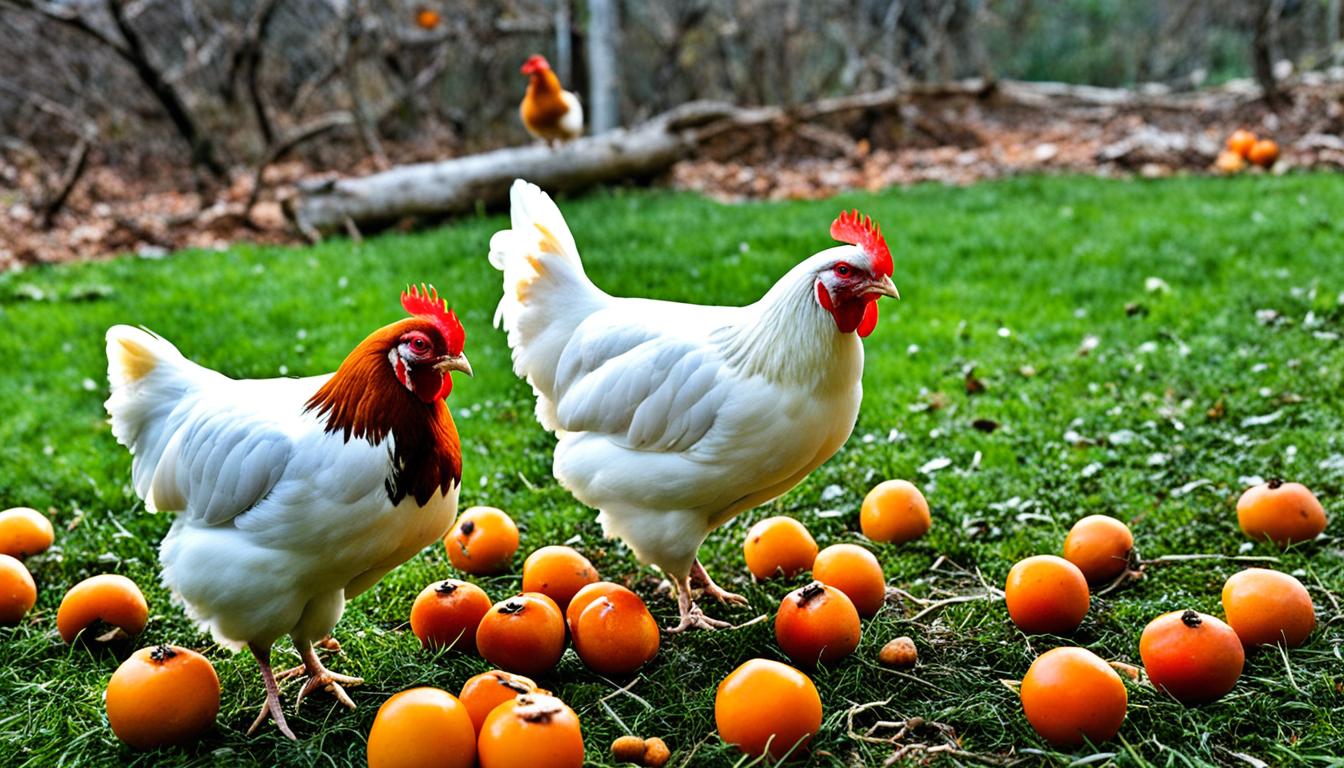
Did you know that chickens can indulge in a diverse range of fruits? Surprisingly, chickens can also enjoy persimmons! These tasty fruits not only give your feathered friends a delicious snack but also provide important nutrients to keep them healthy. However, before you start giving persimmons to your flock, it’s important to learn the proper feeding guidelines to keep them safe and well.
Key Takeaways:
- Chickens can safely eat persimmons in moderation.
- Persimmons provide a vitamin boost, especially during the cold winter months.
- It’s important to limit persimmon intake due to their high sugar content.
- Introduce persimmons gradually to chickens and observe their reactions.
- Consult with a veterinarian for personalized advice on feeding persimmons to your flock.
Persimmons: A Berry for Chickens
When it comes to feeding chickens, the options can sometimes seem limited. However, one fruit that can provide a tasty and nutritious addition to their diet is the persimmon. Whether it’s the Fuyu, Hachiya, or American variety, persimmons are considered a type of berry that chickens can safely enjoy.
Persimmons come in different sizes and colors, ranging from yellow to dark red or orange. This vibrant range adds visual appeal to the chickens’ diet while providing a delectable treat. Chickens are likely to enjoy the sweet and succulent taste of persimmons, making it a popular choice among poultry enthusiasts.
However, it’s important to exercise moderation when feeding persimmons to chickens. Just like other fruits with a high sugar content, persimmons should be given in limited amounts to avoid overindulgence. While chickens can benefit from the vitamins and nutrients found in persimmons, it’s crucial to maintain a balanced diet and not rely solely on this fruity delicacy.
Nutritional Benefits of Persimmons for Chickens
Persimmons offer several nutritional benefits for chickens. They are rich in vitamins, including vitamin A, vitamin C, and vitamin B6. These vitamins support the immune system, promote healthy skin, and boost metabolism. Persimmons also contain folate, thiamin, riboflavin, manganese, and other essential minerals that are vital for the overall health and well-being of chickens.
When chickens consume persimmons, they receive a nutritious and delicious treat that can supplement their regular feed. These vibrant fruits provide a natural source of vitamins and minerals, which are crucial for their growth, development, and overall vitality.
Vitamins in Persimmons
Persimmons are particularly rich in vitamins that offer a range of health benefits for chickens. Let’s take a closer look at the key vitamins found in persimmons and their roles in supporting chickens’ health:
1. Vitamin A
Vitamin A plays a crucial role in maintaining a strong immune system, enhancing vision, and promoting healthy skin and feathers in chickens. It also supports their reproductive health and improves their overall resistance to diseases.
2. Vitamin C
Vitamin C acts as a powerful antioxidant, protecting chickens’ cells from damage caused by free radicals. It also plays a vital role in collagen synthesis, which is essential for healthy skin, bones, and connective tissues.
3. Vitamin B6
Vitamin B6 is involved in various metabolic processes in chickens, including protein synthesis and red blood cell production. It also supports their nervous and immune systems, contributing to their overall health and vitality.
In addition to these key vitamins, persimmons contain other essential nutrients, including folate, thiamin, riboflavin, and manganese. These nutrients play important roles in various bodily functions, such as energy production, DNA synthesis, and bone health in chickens.
However, it’s important to feed persimmons in moderation to avoid oversupplying these nutrients and disrupting the chickens’ balanced diet. Too much of a good thing can be harmful, so it’s crucial to maintain a proper balance between persimmons and their regular feed.
To ensure chickens receive the nutritional benefits of persimmons without overindulging, it’s recommended to offer them small quantities of persimmons as occasional treats. This way, chickens can enjoy the delicious flavor and reap the rewards of the vitamins and minerals found in these delightful fruits.
| Vitamin | Function |
|---|---|
| Vitamin A | Enhances immune system, promotes healthy skin and feathers |
| Vitamin C | Acts as an antioxidant, improves skin health, and supports collagen synthesis |
| Vitamin B6 | Aids in metabolism, protein synthesis, and immune system function |
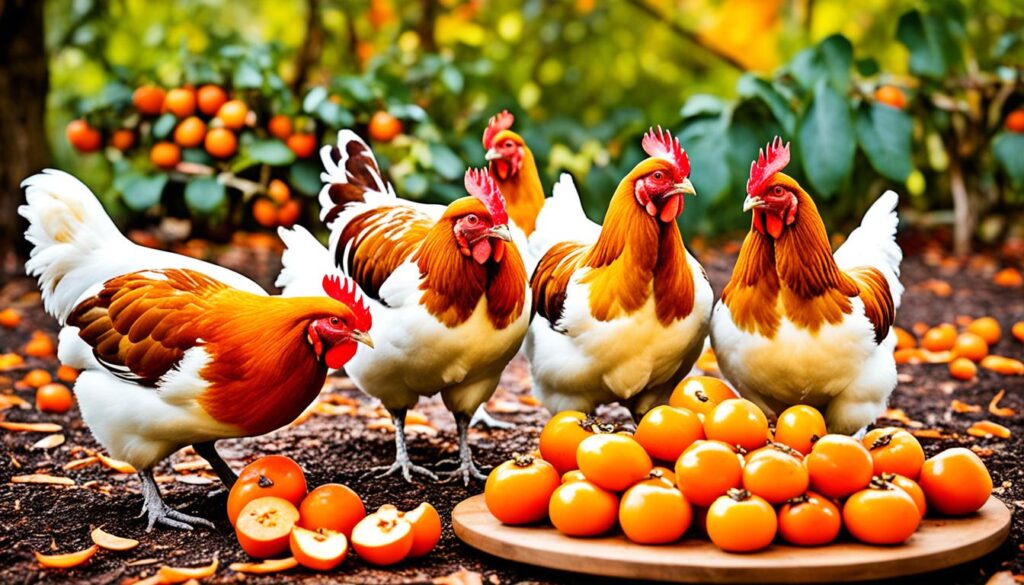
By including persimmons as part of a varied and balanced diet, chickens can enjoy the nutritional benefits of these vibrant fruits while leading healthy and active lives.
Feeding Persimmons to Chickens
To introduce persimmons to chickens, it’s important to start slowly and observe their reaction. Chickens may be hesitant to try new foods, so gradual introduction is key. One effective method is to hang a piece of persimmon in the chicken coop, allowing them to examine it before giving it a try. The soft skin and flesh of persimmons make them easy for chickens to consume, so there’s no need to cut them into small pieces or remove the skin.
Feeding Tips:
- Start by offering small pieces of persimmon.
- Observe the chickens’ reaction and appetite.
- Gradually increase the quantity of persimmons over time.
- Ensure persimmons are ripe and fresh for the best taste.
Once your chickens are accustomed to persimmons, you can make the feeding experience more enjoyable by cutting the fruit into different shapes or even hiding pieces for them to find. This adds a fun and stimulating element to their diet.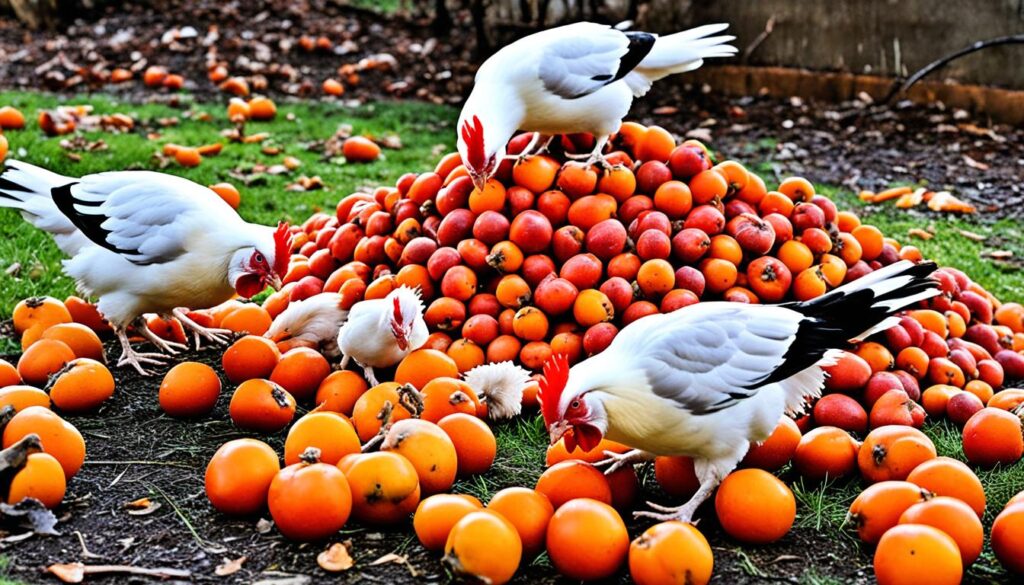
Remember, while persimmons are a healthy treat, they should be given in moderation to maintain a balanced diet for the chickens.
Potential Drawbacks of Persimmons for Chickens
While persimmons are generally safe for chickens to consume, there are a few potential drawbacks and risks associated with feeding persimmons to them. It’s essential for chicken owners to be aware of these considerations to ensure the well-being and health of their flock.
High Sugar Content: One concern when it comes to feeding persimmons to chickens is their high sugar content. Persimmons are naturally sweet fruits, and excessive consumption of high-sugar foods can lead to various health issues for chickens. It is crucial to moderate the quantity of persimmons and avoid feeding them in large quantities to prevent blood sugar imbalances and weight gain.
Health Conditions: Chickens with certain health conditions, such as diabetes or obesity, should be cautious when consuming persimmons. The high sugar content in persimmons can exacerbate these conditions and potentially lead to further health complications. It is advisable to consult with a veterinarian for specific dietary guidelines if your chickens have pre-existing health conditions.
Potential Intestinal Blockages: Another risk associated with persimmons for chickens is the presence of seeds. Persimmon seeds contain tannins, which can clump together and potentially lead to intestinal blockages if chickens consume them excessively. It’s crucial to monitor chickens’ intake and ensure that they don’t overindulge in persimmon seeds, reducing the risk of digestive problems and blockages.
Did You Know? Chickens have a gizzard, which helps them grind and digest their food. However, the seeds of fruits like persimmons can be challenging for a chicken’s digestive system to break down, increasing the risk of blockages.
| Drawbacks of Persimmons for Chickens | Risks of Feeding Persimmons to Chickens |
|---|---|
| High sugar content | Potential blood sugar imbalances |
| Health conditions (diabetes, obesity) | Potential exacerbation of existing health conditions |
| Presence of tannin in seeds | Potential intestinal blockages |
By being cautious and monitoring the quantity and frequency of persimmon feedings, chicken owners can minimize the drawbacks and risks associated with feeding persimmons to their flock. It is always recommended to provide a balanced and varied diet for chickens, consulting with a veterinarian if necessary, to ensure their overall health and well-being.
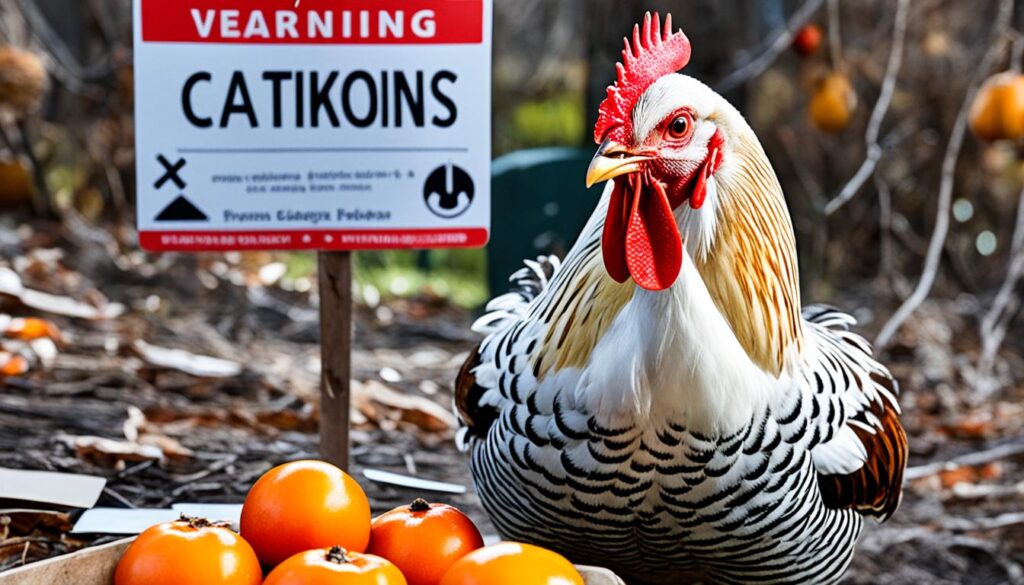
Feeding Persimmon Leaves to Chickens
Chickens can enjoy the benefits of persimmon leaves as part of their diet, but it’s important to offer them in moderation. Persimmon leaves provide fiber and other nutrients that can contribute to the overall digestion and well-being of your chickens.
Before giving persimmon leaves to your chickens, make sure to wash them thoroughly to remove any potential contaminants. Wilted or spoiled leaves should be avoided since they may contain toxins that could be harmful to your chickens.
When introducing persimmon leaves to your chickens for the first time, start with a small quantity and observe their reaction. Some chickens may have preferences, while others may take time to adjust to this new treat. Gradually increase the amount based on their response.
Feeding persimmon leaves to your chickens can be an excellent way to add variety to their diet, allowing them to enjoy the benefits of different nutrients. While persimmon leaves are generally safe for chickens, it’s always essential to monitor their diet and consult with a veterinarian for personalized advice.
Benefits of Persimmon Leaves for Chickens
Persimmon leaves offer several advantages for chickens. They are a rich source of fiber, which aids in digestion and promotes a healthy gut. Additionally, these leaves contain essential minerals and vitamins, such as potassium, manganese, and vitamin C, which contribute to the overall well-being and immune system of your chickens.
The fiber in persimmon leaves can help regulate bowel movements and prevent digestive issues in chickens. It assists in maintaining a healthy and balanced digestive system, allowing your chickens to better absorb nutrients from their food.
The table below highlights some of the key nutritional values of persimmon leaves:
| Nutrient | Amount per 100g |
|---|---|
| Fiber | 6g |
| Potassium | 214mg |
| Calcium | 81mg |
| Manganese | 1.5mg |
| Vitamin C | 43mg |
Remember, while persimmon leaves are beneficial for chickens, it’s important to offer them as part of a diverse diet that includes other healthy food options. Providing a balanced diet is key to maintaining the overall health and happiness of your flock.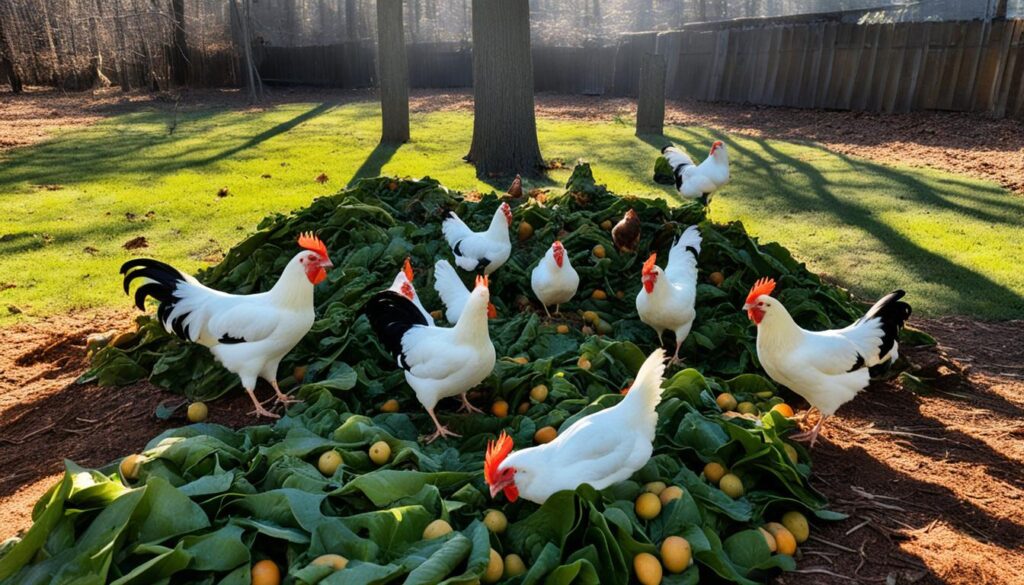
Remember to always introduce new foods gradually and keep a close eye on your chickens’ reaction. By offering persimmon leaves in moderation, you can provide your chickens with a nutritious and enjoyable addition to their diet.
Foods to Avoid Giving Chickens
While chickens can enjoy a variety of foods, it’s important to be aware of the foods that are toxic or harmful to them. By avoiding these foods, you can ensure the health and well-being of your chickens. Some of the foods that should be kept away from chickens include:
- Chocolate: Chocolate contains theobromine, which is toxic to chickens and can lead to symptoms like increased heart rate and tremors.
- Avocado: Avocado contains persin, a toxin that can be lethal to chickens if ingested in large quantities. It’s best to completely avoid feeding avocados to chickens.
- Lemons and oranges: Citrus fruits like lemons and oranges are highly acidic, which can upset the digestive system of chickens. While small amounts can be given as an occasional treat, it’s best to limit their intake.
- Processed foods: Foods that are high in salt, sugar, or artificial additives should be avoided. These can be harmful to chickens and can lead to various health issues.
Instead of these toxic or unhealthy foods, focus on offering safe and nutritious options for your chickens. Here are some examples:
- Vegetables: Leafy greens, carrots, peas, and cucumbers are all excellent choices for chickens. These vegetables provide essential vitamins and minerals.
- Fruits: Safe fruits for chickens include apples, berries, and watermelon. These fruits offer natural sweetness and hydration.
- Grains: Whole grains like oats and rice can be given to chickens in small amounts for added nutrition.
- Protein-rich options: Eggs or mealworms are great sources of protein for chickens. These can be offered as treats to supplement their diet.
By avoiding toxic foods and focusing on safe and nutritious options, you can ensure that your chickens stay healthy and happy.
| Toxic Foods for Chickens | Safe and Nutritious Alternatives |
|---|---|
| Chocolate | Vegetables: leafy greens, carrots, peas |
| Avocado | Fruits: apples, berries, watermelon |
| Lemons and oranges | Grains: oats, rice |
| Processed foods | Protein-rich options: eggs, mealworms |
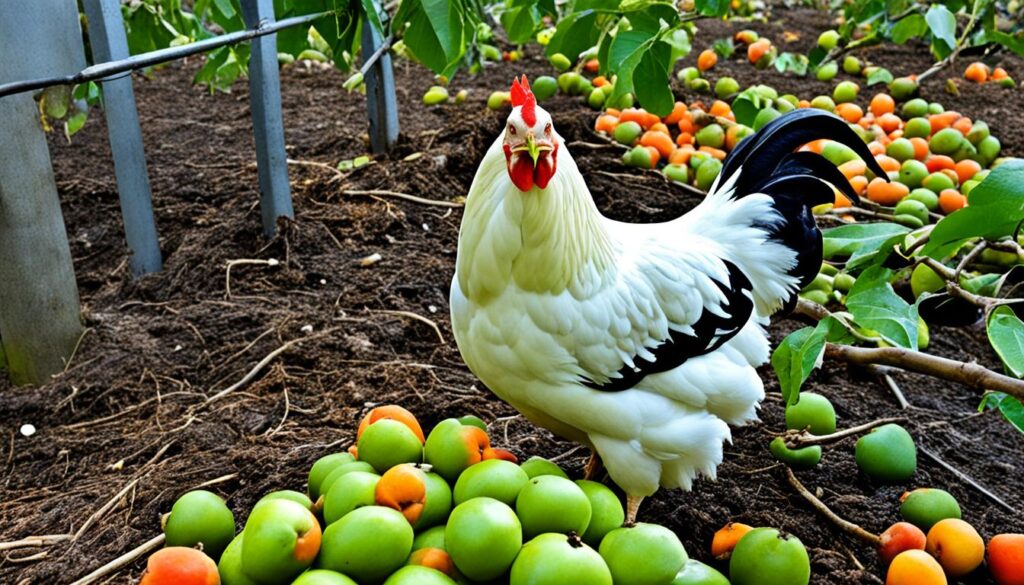
Can Chickens Eat Persimmons Skin?
Chickens can safely enjoy persimmon skins as part of their diet, as long as the skin is clean and free from pesticides. Persimmon skins contain additional nutrients and fiber, which can be beneficial to the chickens’ health. However, it’s important to offer the skin in moderation to avoid digestive issues, as it can be high in sugar. Introducing new foods gradually to chickens and monitoring their reactions is recommended to ensure their well-being. If any discomfort or digestive problems arise, it’s advisable to reduce or eliminate persimmon skin from their diet.
| Benefit | Description |
|---|---|
| Nutritional Value | Persimmon skins are rich in nutrients such as vitamins and fiber, which can contribute to the overall health of the chickens. |
| Moderation | Offering persimmon skins in moderation can help prevent excessive sugar intake and potential digestive issues. |
| Introduction | Gradually introducing new foods like persimmon skins allows for proper adjustment and observation of any adverse reactions. |
Feeding persimmon skins to chickens provides them with additional nutrients while enticing their taste buds. However, it’s essential to remember that persimmon skins should not replace their main diet, which should primarily consist of balanced commercial chicken feed.
List of Other Safe Fruits for Chickens
- Apples
- Bananas
- Berries
- Cantaloupe
- Grapes
- Kiwi
- Mango
- Peaches
- Pumpkins
- Watermelon
Remember to prioritize their regular feed and consult with a veterinarian for personalized advice.
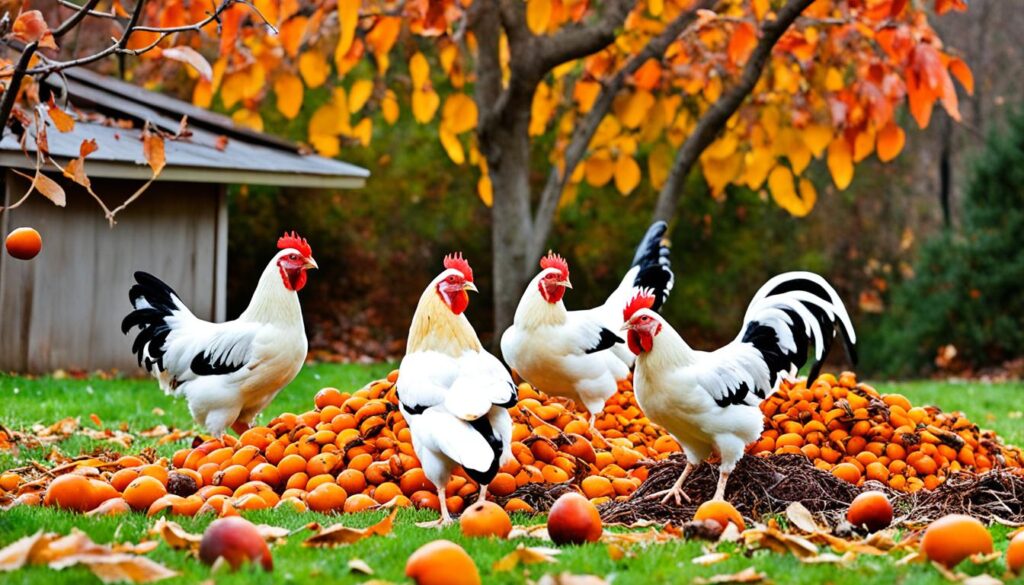
Including a variety of fruits in a chicken’s diet can provide essential vitamins, minerals, and hydration. However, it’s crucial to offer fruits as occasional treats rather than a substantial part of their daily nutrition. By maintaining a balanced and varied diet, chickens can enjoy persimmon skins and other safe fruits as part of a healthy lifestyle.
What Fruits Should I Give to My Chickens?
Chickens can enjoy a variety of fruits as occasional treats. Incorporating safe fruits into their diet provides essential vitamins, minerals, and hydration. However, it’s important to remember that fruits should only make up a small portion of their overall diet, with the main focus on a balanced commercial chicken feed.
Here are some safe fruits that you can give to your chickens:
- Apples
- Bananas
- Berries
- Cantaloupe
- Grapes
- Kiwi
- Mango
- Peaches
- Pumpkins
- Watermelon
These fruits not only provide a tasty treat but also offer a range of nutritional benefits. For example, bananas are a great source of potassium, while berries are packed with antioxidants. Watermelon and cantaloupe help keep chickens hydrated, especially during hot summer months.
It’s important to introduce these fruits in moderation to prevent overindulgence and ensure a balanced diet. Too much fruit can be disruptive to their digestive system or lead to obesity. Monitor their intake and observe any changes in behavior or health to ensure their well-being.
Benefits of Safe Fruits for Chickens
| Fruit | Nutritional Benefits |
|---|---|
| Apples | High in fiber and contain vitamins A, C, and E |
| Bananas | Rich in potassium and vitamin B6 |
| Berries | Packed with antioxidants and vitamin C |
| Cantaloupe | Hydrating and a good source of vitamins A and C |
| Grapes | Contain antioxidants and vitamins C and K |
| Kiwi | Rich in vitamin C, fiber, and folate |
| Mango | High in vitamins A and C |
| Peaches | Provide vitamins A and C |
| Pumpkins | Rich in beta-carotene and a good source of fiber |
| Watermelon | Hydrating and contains vitamins A and C |
Remember to always wash fruits thoroughly, remove any pits or seeds, and serve them in appropriate sizes for chickens. By offering a variety of safe fruits as occasional treats, you can keep your chickens happy, healthy, and entertained.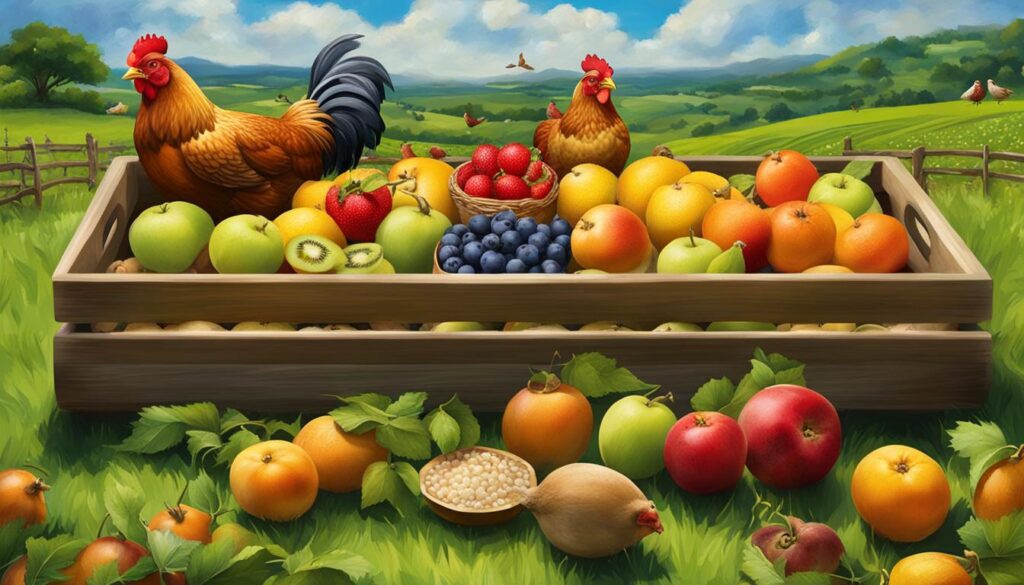
Conclusion
In conclusion, persimmons can be safely incorporated into a chicken’s diet as part of a balanced feeding routine. These delicious fruits offer a range of nutritional benefits, including essential vitamins and minerals that contribute to the overall well-being of chickens.
However, it’s important to feed persimmons to chickens in moderation. While persimmons are a natural source of sweetness, their high sugar content can cause issues if consumed excessively. Therefore, it’s crucial to monitor the quantity of persimmons and ensure they are not overindulging.
Additionally, it’s essential to consider potential drawbacks when feeding persimmons to chickens. Chickens with specific health conditions, such as diabetes or obesity, should have their persimmon intake limited. Moreover, care should be taken to prevent intestinal blockages that may occur if chickens consume an excessive amount of persimmon seeds.
To safely introduce persimmons into a chicken’s diet, it’s recommended to start gradually and observe their response. By offering a varied selection of treats alongside persimmons, chickens can enjoy a diverse diet while receiving the necessary nutrients. Prioritizing their regular feed is also vital to maintain a balanced nutritional intake.
FAQ
Can chickens eat persimmons?
Do persimmons provide any nutritional benefits to chickens?
How should I introduce persimmons to my chickens?
Are there any potential risks or drawbacks to feeding persimmons to chickens?
Can chickens eat persimmon leaves?
Are there any foods that I should avoid giving to chickens?
Can chickens eat persimmon skin?
What other fruits can I give to my chickens?
Is it safe to feed persimmons to chickens?
Paul’s love for animals knows no bounds. As a dedicated writer and animal lover, Paul brings a unique perspective to our team. His firsthand experiences with various animals enrich our content and provide valuable insights into their behavior and needs. Whether he’s sharing tips for pet care or shedding light on pressing conservation issues, Paul’s passion for animals shines through in everything he does.
-

 Vetted1 month ago
Vetted1 month ago15 Best Dog Food Brands Recommended by Vets for Healthy and Happy Pups
-

 Vetted1 month ago
Vetted1 month ago14 Best Homemade Dog Food Recipes Your Pup Will Love – Vet Approved & Nutritious
-

 Vetted1 month ago
Vetted1 month ago15 Best Cat Foods for Managing Hyperthyroidism – Vet Approved and Feline Friendly
-
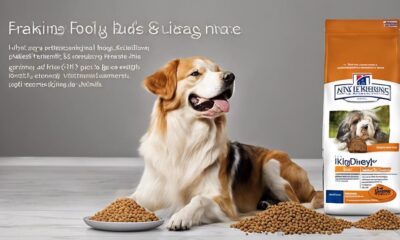
 Vetted3 weeks ago
Vetted3 weeks ago15 Best Dog Foods for Kidney Disease – Expert Recommendations for Your Pet's Health
-

 Vetted2 weeks ago
Vetted2 weeks ago15 Best Affordable Cat Foods That Won't Break the Bank
-
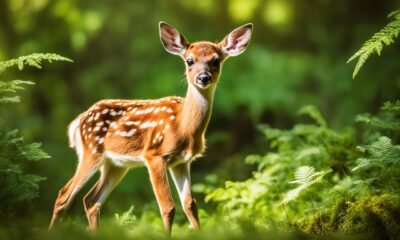
 Deers1 month ago
Deers1 month agoCaring for Baby Deer: Tips for Healthy Fawns
-
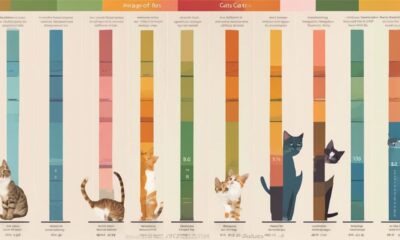
 Cats6 days ago
Cats6 days agoCat Weight Chart by Age: Kitten to Senior in Lbs
-

 Vetted1 month ago
Vetted1 month ago15 Best Kibble Dog Foods for a Healthy and Happy Pup





















